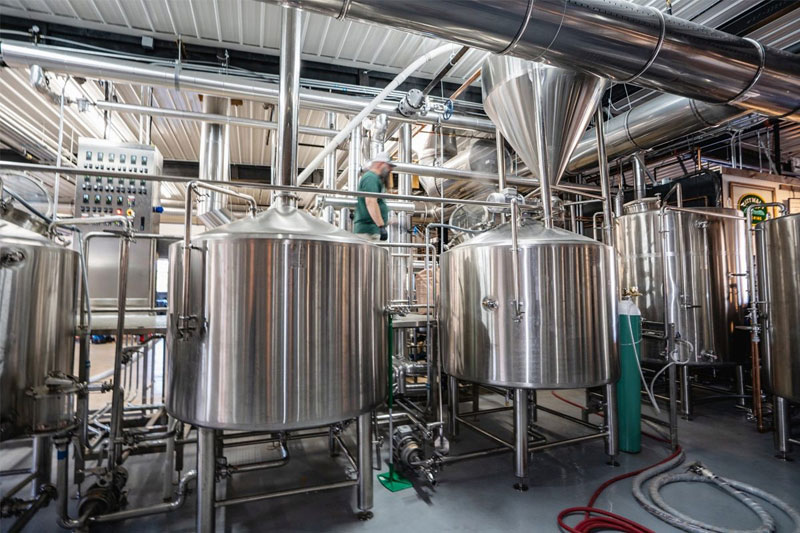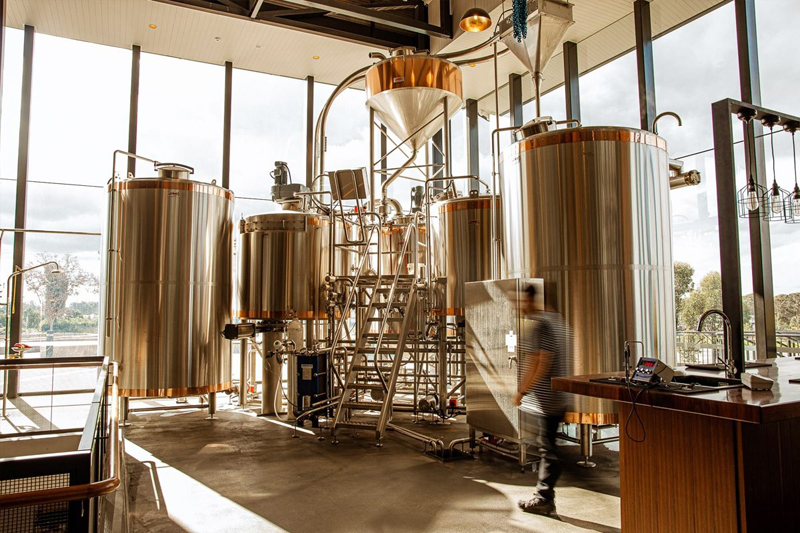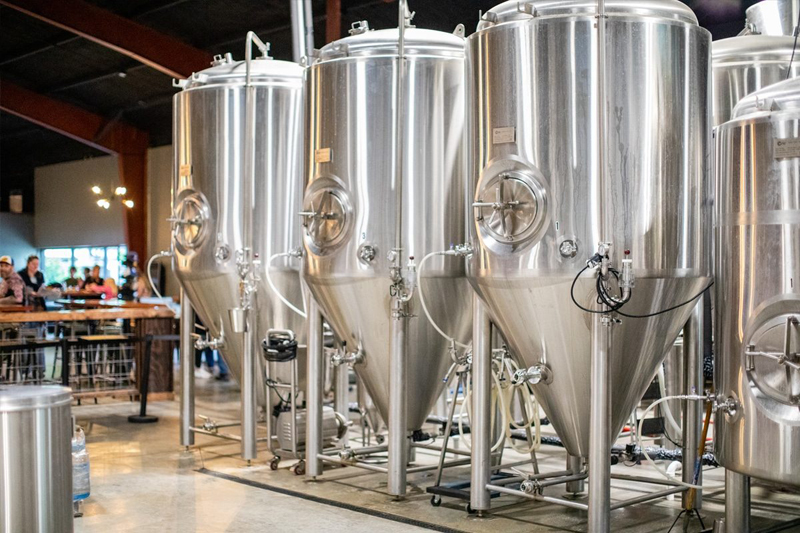What role does oxygen play in beer?

I.The Impact Of Oxygen On Beer Quality
Understanding the effects of oxygen on beer quality can help brewers produce higher-quality beer. Oxygen plays a multifaceted role, with both positive and negative effects that can significantly influence the final product.
Positive Effects
Yeast Health And Fermentation
&Wort Aeration: Oxygen is essential during the initial stages of brewing, particularly during wort aeration. Introducing oxygen to the wort before fermentation begins helps yeast cells synthesize sterols and fatty acids, which are crucial for building healthy cell membranes. This results in robust yeast growth and activity, ensuring a vigorous and consistent fermentation process.
&Fermentation Efficiency: Adequate oxygenation at this stage supports the yeast’s metabolic functions, allowing for efficient sugar consumption and the production of desired flavors and aromas. This initial oxygenation helps prevent fermentation issues such as stuck or sluggish fermentations, leading to a more predictable and controlled brewing process.
Negative Effects
Oxidation
&Off-Flavors: Once fermentation has begun, oxygen becomes detrimental. Oxygen ingress at this stage can lead to oxidation, which causes undesirable flavors in the beer. Common off-flavors associated with oxidation include notes of wet cardboard, paper, or sherry-like characteristics. These flavors are generally considered unpleasant and can significantly diminish the overall quality of the beer.
&Aroma Degradation: Oxidation also negatively impacts the beer’s aroma. It can dull the vibrant hop and malt aromas that brewers strive to achieve, resulting in a less aromatic and enjoyable beer.
Shelf Life Reduction
&Stability Issues: The presence of oxygen post-fermentation can drastically reduce the beer’s shelf life. Oxidized beer tends to stale more quickly, making it less appealing to consumers over time. For commercial brewers, maintaining product stability on store shelves is essential, and oxidation can compromise this.
&Microbial Growth: Oxygen can also promote the growth of unwanted microbes in the beer, leading to spoilage and potential health risks. This is particularly concerning for beers with longer aging processes, where any oxygen ingress can have prolonged negative effects.
Color Changes
&Darkening Effect: Oxygen exposure can cause the beer to darken over time. This color change is a result of oxidative reactions with polyphenols and other compounds in the beer. While this may not directly affect flavor, it can impact the visual appeal of the beer, which is an important aspect of the overall drinking experience.
The impact of oxygen on beer quality is profound and multifaceted. While it plays a beneficial role during the initial stages of brewing by supporting yeast health and fermentation efficiency, its presence post-fermentation can lead to significant quality issues. By understanding both the positive and negative effects of oxygen, brewers can implement effective strategies to control oxygen levels, ensuring the production of high-quality, stable, and flavorful beer.

II. The Role Of Oxygen In Different Stages Of Brewing
Effective oxygen control is critical throughout the brewing process, from the handling of raw materials to the final packaging of beer. Each stage requires specific attention to oxygen levels to ensure the highest quality and stability of the final product. Here’s an in-depth look at the role of oxygen during each stage of brewing:
Raw Material Handling
Importance
&Oxygen can cause raw materials, especially malt and hops, to degrade, leading to off-flavors and reduced brewing quality.
Role Of Oxygen
&Malt: Exposure to oxygen can cause malt to oxidize, resulting in stale flavors. Proper storage in airtight containers in a cool, dry place is essential to maintain freshness.
&Hops: Hops are highly sensitive to oxygen, which can lead to the loss of essential oils and aromatic compounds. Vacuum-sealed or nitrogen-flushed packaging and storage in a freezer can significantly reduce oxidation.
Mashing And Lautering
Importance
&Minimizing oxygen exposure during mashing and lautering helps preserve the wort’s quality and prevents unwanted oxidation reactions.
Role Of Oxygen
&Mashing: Oxygen introduced during mashing can lead to the oxidation of polyphenols and other compounds, resulting in undesirable flavors. Gentle stirring and covering the mash tun can minimize oxygen contact.
&Lautering: When separating the wort from the spent grains, excessive splashing can introduce oxygen. Use gentle sparaging techniques and keep the wort covered to limit exposure.
Boiling
Importance
&Boiling helps to drive off oxygen and other volatile compounds, creating a stable wort environment for fermentation.
Role Of Oxygen
&Oxygen Removal: A vigorous boil expels dissolved oxygen, which is crucial to prevent oxidation of wort components.
&Volatile Compound Reduction: Boiling with the lid off allows volatile compounds such as dimethyl sulfide (DMS) to evaporate, improving the wort’s quality.
Cooling
Importance
&Rapid cooling of the wort to fermentation temperature is necessary to prevent microbial contamination and oxidation.
Role Of Oxygen
&Wort Chillers: Efficient wort chilling systems (immersion, counterflow, or plate chillers) minimize the time the wort is exposed to oxygen. Ensuring all connections are airtight prevents oxygen ingress.
&Closed Systems: Utilizing a closed system for transferring cooled wort to the fermentation tank helps maintain an oxygen-free environment, essential for the next stages.
Fermentation
Importance
&Oxygen helps keep the yeast healthy at the beginning of fermentation, but once fermentation begins, oxygen must be minimized to prevent oxidation.
Role Of Oxygen
&Wort Aeration: Introducing oxygen before fermentation supports yeast growth and reproduction by facilitating the synthesis of sterols and fatty acids.
&Anaerobic Conditions: After initial oxygenation, fermentation must occur in an anaerobic environment. Using sealed fermenters with airlocks or blow-off tubes and purging with CO2 helps maintain this environment.
Post-Fermentation
Importance
&Protecting beer from oxygen during transfer and aging preserves its quality and extends its shelf life.
Role Of Oxygen
&Closed Transfers: Moving beer between vessels should be done using closed systems and purging with CO2 or nitrogen to avoid oxygen exposure.
&Inert Gas Blanket: Maintaining a CO2 or nitrogen blanket over the beer during storage prevents oxidation and microbial growth.
Packaging
Importance
&Proper packaging techniques are essential to protect the beer from oxygen, ensuring it remains fresh and flavorful until consumption.
Role Of Oxygen
&Purging Containers: Before filling, purge bottles, cans, and kegs with CO2 to eliminate oxygen. This step is critical to preventing oxidation during packaging.
&Counter-Pressure Filling: Using counter-pressure filling methods helps maintain carbonation and minimizes oxygen ingress.
&Oxygen-Scavenging Materials: Employing oxygen-absorbing caps and liners can further reduce the risk of oxidation in the packaged beer.
Oxygen management is a vital component of the brewing process, influencing the quality and stability of beer at every stage. From raw material handling to final packaging, careful control of oxygen levels ensures the production of high-quality, stable, and flavorful beer. By understanding the role of oxygen and implementing best practices, brewers can protect their beer from oxidation and maintain its intended character and freshness.

III.Oxygen Control During Brewing Stages
Effective oxygen control is essential at every stage of the brewing process to ensure the production of high-quality beer. Each step, from raw material handling to packaging, requires specific techniques to manage oxygen levels and prevent undesirable effects such as oxidation. Here’s a detailed guide on how to control oxygen during each stage of brewing:
Raw Material Handling
&Objective: Preserve the freshness and quality of raw materials.
Malt Storage
&Technique: Store malt in airtight containers in a cool, dry environment.
&Rationale: Prevents oxidation, which can cause staleness and off-flavors in the malt.
Hops Storage
&Technique: Use vacuum-sealed or nitrogen-flushed packaging and store hops in a freezer.
&Rationale: Protects delicate hop oils and aromatic compounds from oxidation.
Mashing And Lautering
&Objective: Minimize oxygen exposure to prevent oxidation of wort components.
Mashing
Technique: Use gentle stirring and cover the mash tun.
Rationale: Reduces the introduction of oxygen, preserving the wort’s quality.
Lautering
Technique: Implement gentle sparging techniques and keep the wort covered.
Rationale: Prevents oxygen pickup during the separation of wort from spent grains.
Boiling
&Objective: Drive off unwanted oxygen and volatile compounds.
Vigorous Boil
&Technique: Maintain a strong, rolling boil with the kettle lid off.
&Rationale: Expels dissolved oxygen and allows undesirable compounds like dimethyl sulfide (DMS) to evaporate.
Cooling
Objective: Prevent oxygen pickup while cooling the wort to fermentation temperature.
Wort Chillers
&Technique: Use immersion, counterflow, or plate chillers with airtight connections.
&Rationale: Rapidly cools the wort while minimizing oxygen exposure.
Closed Cooling Systems
&Technique: Transfer cooled wort directly to the fermenter using sanitized, airtight hoses and fittings.
&Rationale: Maintains an oxygen-free environment during transfer.
Fermentation
&Objective: Ensure optimal yeast health with initial oxygenation and maintain anaerobic conditions thereafter.
Wort Aeration
&Technique: Aerate wort using methods like shaking, aeration stones, or pure oxygen systems.
&Rationale: Provides the necessary oxygen for yeast to synthesize sterols and fatty acids, promoting healthy fermentation.
Sealed Fermenters
&Technique: Use fermenters with tight-fitting lids, airlocks, or blow-off tubes.
&Rationale: Prevents oxygen ingress while allowing CO2 to escape, maintaining anaerobic conditions.
CO2 Purging
&Technique: Purge fermenters with CO2 before filling them with wort.
&Rationale: Displaces residual oxygen, creating a safe environment for fermentation.
 Jinan Alston Equipment Co.,Ltd.
Jinan Alston Equipment Co.,Ltd.